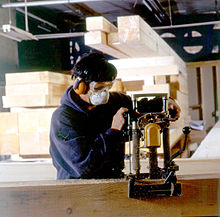

Joinery is a part of woodworking that involves joining pieces of wood, engineered lumber, or synthetic substitutes (such as laminate), to produce more complex items. Some woodworking joints employ mechanical fasteners, bindings, or adhesives, while others use only wood elements (such as dowels or plain mortise and tenon fittings).
The characteristics of wooden joints—strength, flexibility, toughness, appearance, etc.—derive from the properties of the materials involved and the purpose of the joint. Therefore, different joinery techniques are used to meet differing requirements. For example, the joinery used to construct a house can be different from that used to make cabinetry or furniture, although some concepts overlap. In British English joinery is distinguished from carpentry, which is considered to be a form of structural timber work;[1] in other locales joinery is considered a form of carpentry.